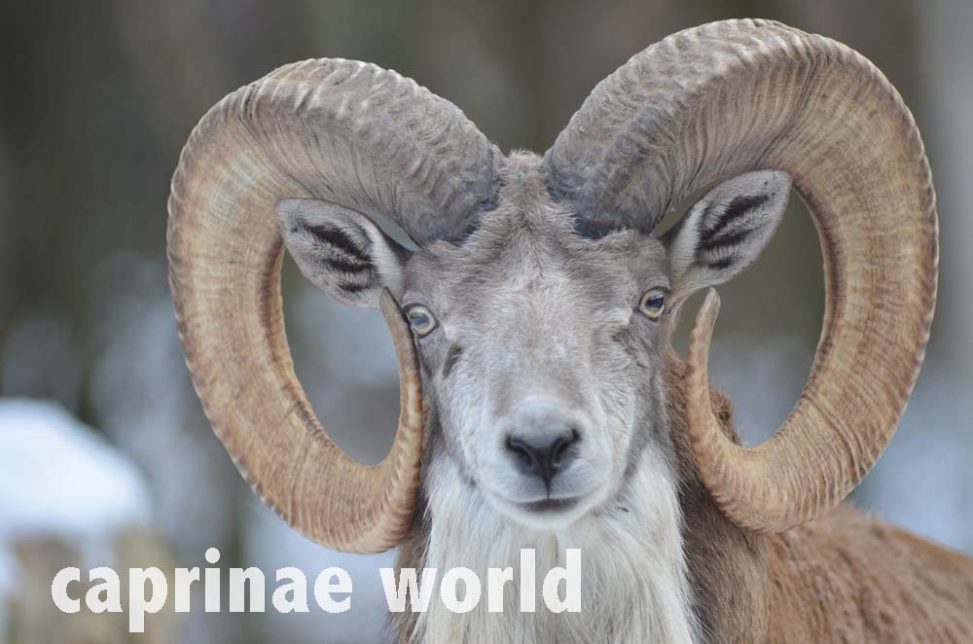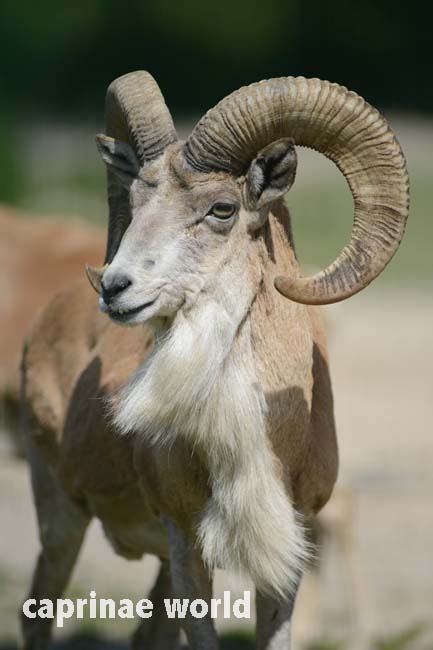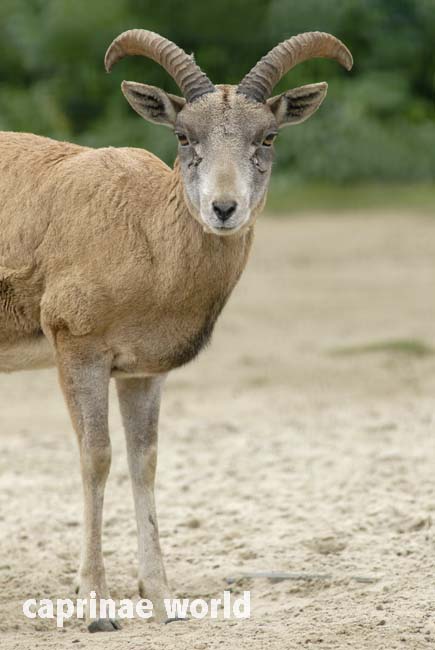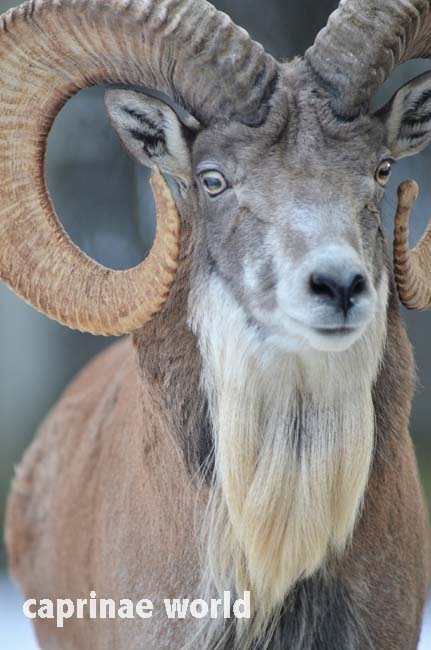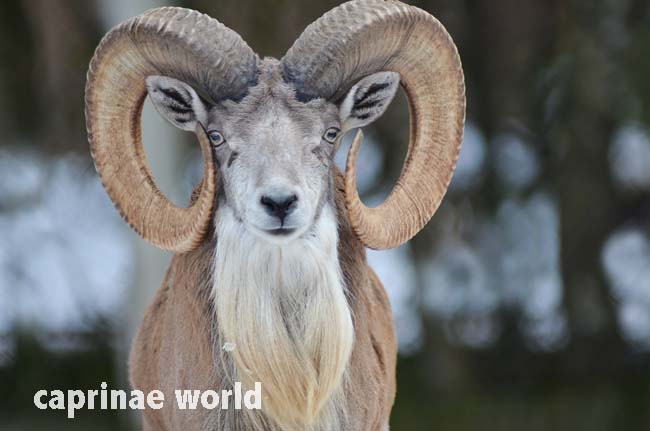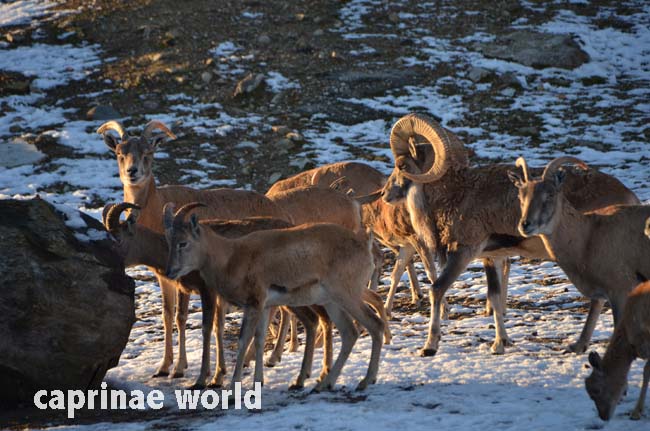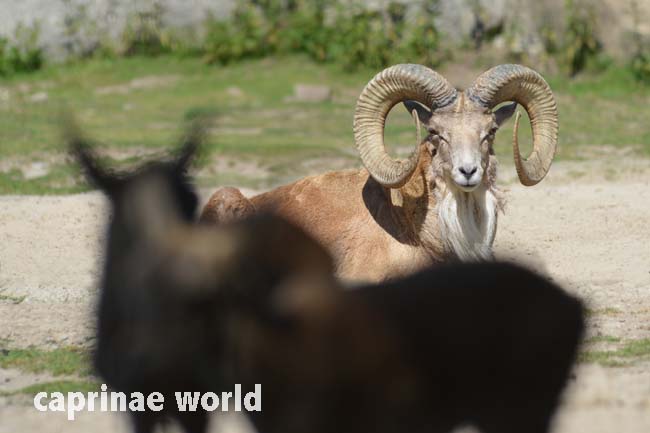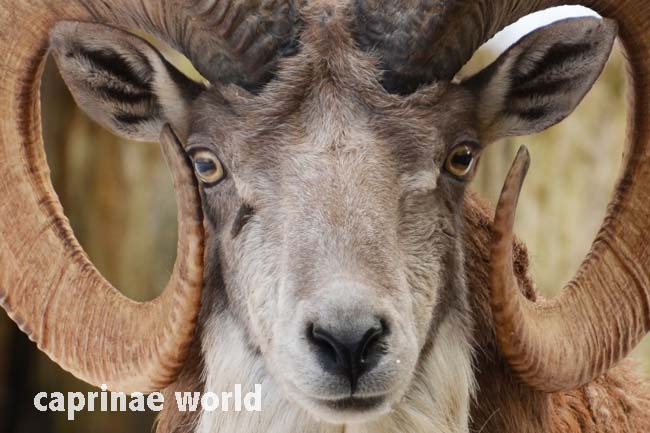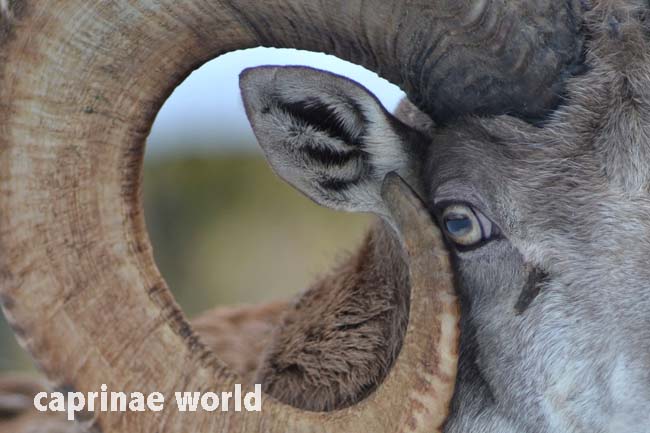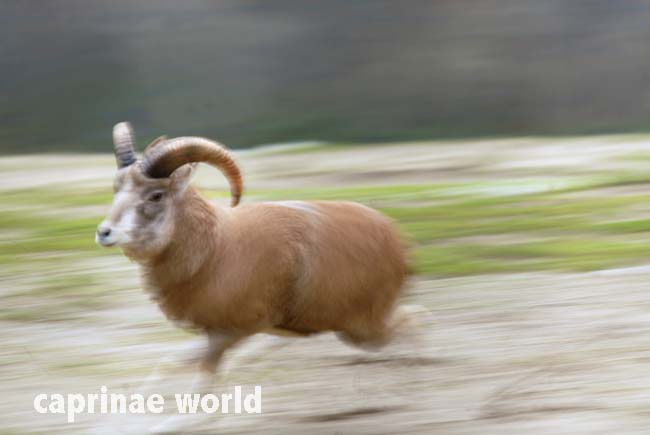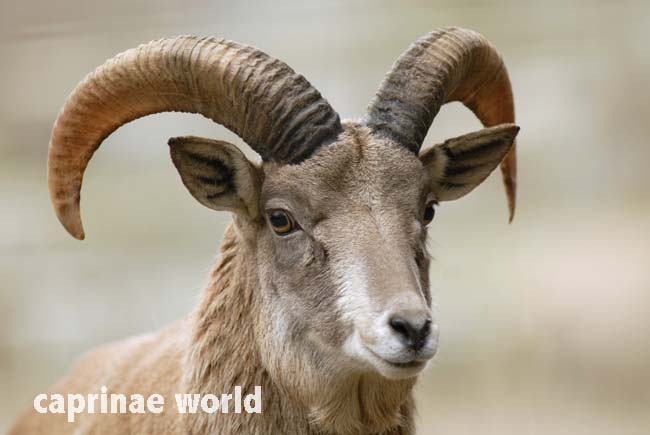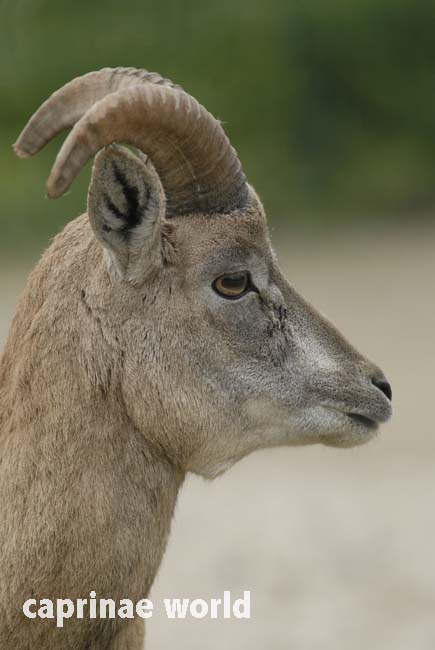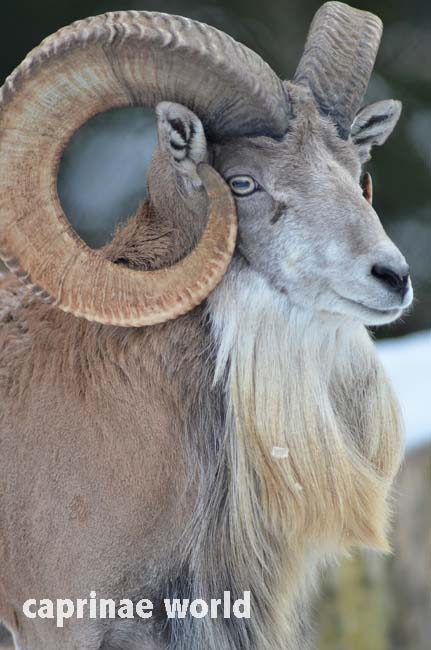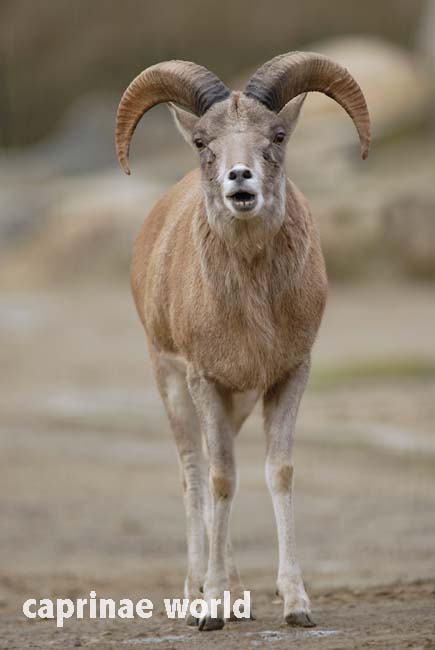The Transcaspian Urial occurs east of the Caspian Sea. In Iran it is the largest wild sheep, and only slightly smaller than the Ladakh Urial.
Name
English common name: Transcaspian Urial, aka Arkal, Kopet Dagh Urial, Ustyurt Urial [2]
Farsi (Persian): Quch-e-urial [2]
German: Transkaspisches Kreishornschaf [2] ((editor’s note: the term „Kreishorn“ derives from cycloceros – the epithet of the Afghan Urial, meaning „circle(d) horn“ (cycl- ≈ Greek: circle and cer(at) ≈ Greek: horn, antler, peak). The term „Kreishornschaf“ has been applied to the Transcaspian type as well to show the close relationship to the Afghan Urial. As a common name „Kreishornschaf“ should be generally abandoned, because it doesn’t help at all to describe a wild sheep, since all sheep basically have „circled horns“. To bring the term into line with international nomenclature it seems advisable to stick to „Transkaspischer Urial“))
French: Urial Transcaspien [2]
Spanish: Urial del Trans-Caspio [2]
Other (putative) scientific names and synonyms
Ovis orientalis arkar [arcal], Eversmann 1850 [2]
Ovis vignei varentsowi, Satunin 1905, Kopet Dagh Mountains, Turkestan [13]
Ovis arcar dolgopolovi, Nasonov 1913 [2, 13]
Ovis orientalis varentsovi, Nasonov 1913 [2]
Ovis vignei elbursica, author unknown [2]
The name orientalis is based on a hybrid population in North-central Iran and therefore is not usable. [16]
Taxonomy
Ovis vignei arkal, Eversmann 1850 [2],
type locality: Ust-Urt Plateau (situated southwest of Lake Aral), Soviet Union [13]
Some authors see the Transcaspian Urial as a subspecies (Ovis cycloceros arkal) of the Afghan Urial (Ovis cycloceros) [16], with which it is most closely related.
Karyotype: 2n=58 [2]
Similar subspecies
The Transcaspian Urial is said to have a white ruff and a white bib, while the Afghan Urial (Ovis vignei cycloceros) has a black ruff and a white bib. (16)
More reasons for splitting Transcaspian Urials from other Urials
Groves and Grubb (2011) show that Transcaspian Urial, Bukhara Urial and Ladakh Urial are distinct. The Transcaspian Urial differs especially from the Bukhara Urial in skull length and breadth, and the frontal arc, contrasting with a low frontal chord. (4)
Table 1: Scull measurements (mm) of Transcaspian Urial and Bukhara Urial
| skull length | scull breadth | frontal arc | frontal chord | |
| Transcaspian | ||||
| Mean | 273,39 | 144,47 | 133,00 | 94,12 |
| N | 36 | 34 | 26 | 24 |
| Std dev | 7,530 | 5,440 | 10,855 | 6,707 |
| Min | 252 | 132 | 112 | 81 |
| Max | 297 | 155 | 150 | 108 |
| Bukhara | ||||
| Mean | 250,40 | 130,90 | 125,50 | 91,13 |
| N | 10 ⚡ | 10 ⚡ | 8 ⚡ | 8 ⚡ |
| Std dev | 12,937 | 9,098 | 9,562 | 5,668 |
| Min | 233 | 118 | 115 | 83 |
| Max | 272 | 151 | 140 | 100 |
One basic information that can be extracted from this table: The sculls of Transcaspian Urials are on average 2 cm longer and 1 cm broader than sculls of Bukhara Urials. For Groves and Grubb (2011) this is one of the main arguments to separate the two phenotypes as distinct species. (⚡: survey sample size is very small!)
Distribution

Distribution ranges of Transcaspian Urial (Ovis vignei arkal), Afghan Urial (Ovis vignei cycloceros) and Blanford Urial (Ovis vignei blanfordi). The distribution range of the Transcaspian Urial is basically east of the Caspian Sea. It is very likely that this range is separated from the Afghanistan Urial’s range further southeast. Some authors see all three subspecies as a distinct species: Afghan Urial (Ovis cycloceros). Map source: OpenTopoMap
by country: Kazakhstan, Uzbekistan, Turkmenistan, Iran [7], Afghanistan [2]
in detail:
– Ustyurt Plateau (transboundary desert shared by Turkmenistan, Uzbekistan and Kazakhstan). There it occurs in the ravines surrounding the plateau [7] as well as the coastal cliffs and low mountains along the eastern shore of the Caspian Sea [2] and Kaplankyr [7]

Young Transcaspian Urial ram at the northwesterly edge of the subspecies distribution range. Photo: Francis Morlon, Fetisovo Plateau, Kazakhstan, 2009-05-01
– Mangyshlak Peninsula (mainly within Uzbekistan, including the southwesternmost fringe of Kazakhstan): Here Urial occur in the Karagiye Depression and the table mountains of north Aktau in the central and northern parts of the peninsula. [2]
((editor’s note: The Ustyurt Plateau can be seen as a part of the Mangyshlak Peninsula))
– Balkhan Range (Nebit Dagh: 1.880 m, Western Turkmenistan) extending southeastwards into the Kopet-Dagh (on the border to Iran) and further into southeastern Turkmenistan: There in all likelihood the distribution range straddles the border to and enters into Afghanistan. [2]
Valdez (2008) mentions more locations, which were not assignable: the moderately high mountains of Karatau; to the south to Kara-Bogaz-gol; similar habitat in Karagie, Kaunda, Kazakhla, Kulandaga, Kazakhly-Sora and other areas [7]
Iran (northeast): [2]
– Alborz Mountains (eastern section), from the extreme east of Mazandaran and northern Semnan provinces
– Kopet Dagh Mountains in Golestan and North Khorasan provinces (along the Iranian border with Turkmenistan)
– Heidary Wildlife Refuge (northeast of the city of Mashad), Binalood and Hezr-masied Mountain Ranges (spelling according to google maps: Kuhha-ye Hezar Masjed / Hezármasdžed; north of the city of Mashad)
Hybrids and the purest: In the Alborz Mountains (Iran, Semnan Provinz) a hybridisation zone with „classic“ Transcaspian Urial, Armenian Mouflon and individuals with hybrid characteristics exist, even within the same herd. [2] The purest form of the Transcaspian Urial in Iran is found in Golestan, Gorkhod, Serany and Tandoreh Protected Areas [7]
Transcaspian Urial and its neighbours to the east: Weinberg (2010) states that Bukhara Urial (O. v. bocharensis) do not occur west of the Kugitang Mountains. Therefore the ranges of these two subspecies do not touch. [2]
In the southeasterly extension of the Transcaspian Urial’s range, where the borders of Iran, Turkmenistan and Afghanistan come together, the Transcaspian Urial range probably touched the range of the Afghan Urial (O. c. cycloceros) in historic times. Today the plains in the east-central part of Razavi Khorasan Province possibly act as a break. [2]
General discription
Because of the large distribution area and plasticity of urials in the area it is difficult to describe „THE typical“ Transcaspian Urial. In Iran it is the largest wild sheep, only slightly smaller in body size than the Ladakh Urial. [2] Few measurements are available.
shoulder height males: 95 cm [2]
weight adult males from Iran: up to 90 kg [2]
weight adult males from Kazakhstan: 52 kg [2]
weight subadult males 2 to 3 years and females: 50-55 kg [2]
Colouration / pelage
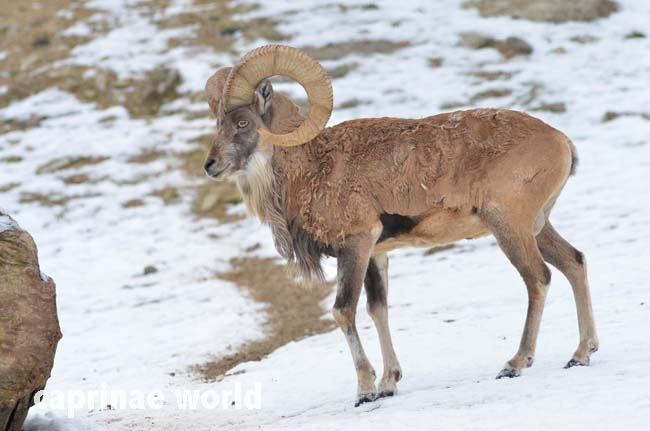
General colour of upper parts in Transcaspian Urial is yellowish-rusty. [2]. Photo: Ralf Bürglin, Tallinn
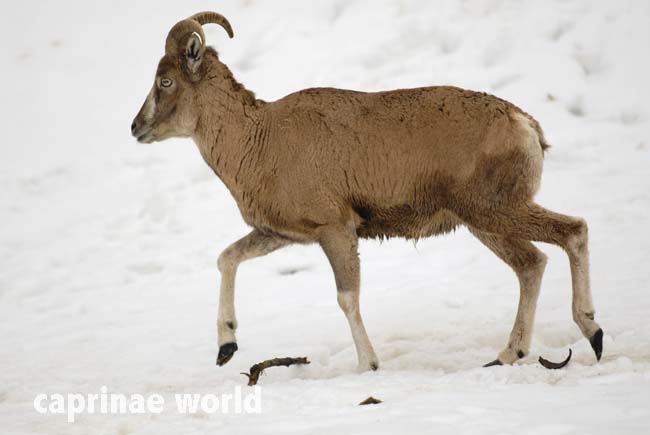
Transcaspian Urial female. General colour in this specimen is yellowish-brown. Note that bib and neck ruff are absent. Photo: Ralf Bürglin, Chomutov
summer coat: of lighter shades [2]
underparts: white [2]
lateral stripe: dark brown; separates the upper parts from the white underparts; not very visible in the summer coat [2]; compare with photo of male above: lateral stripe is black and incomplete
rump / caudal patch: dirty white; present in both sexes [2]
shoulder spot: some males; dark; in winter coat [2]
limbs: area from „knee“ to pastern is white in adults [2]
face: sides are brown mixed with white; hairs around muzzle are pure white [2]
Most distinctive feature
In Transcaspian Urial both bib and neck ruff are conspicuously white [16], especially in winter coat [2]. In contrast the Afghan Urial (O. v. cycloceros) possesses a white bib (throat ruff) and a black neck ruff [16]. However in younger Transcaspian Urial rams the neck ruff can be also dark. And in summer, bib and ruff are much less conspicuous. Ewes have neither ruff nor bib [2].
Horns
Horns grow in a tight circle or form an open spiral. [13] They have distinct corrugations. [2] The frontal surface is flat [13], with sharply angled anterior edges. [2] Cross-section is triangular. [13]
Direction of horn growth: Horns either come with an open spiral of a diverging outward curl (homonymous type: right horn grows in a right-handed spiral) or a tight inward converging curl (heteronymous type: right horn grows in a left-handed spiral)
horns of ewes: have usually short horns; but Nasonov (1923, pp. 46, 51) mentions that ewes of dolgopolovi are hornless, while those of arkal are horned. [2]
horn length median (n=326): 92,4 cm [2]
circumference median: 27 cm [2]
tip-to-tip-spread median: exceeds 44 cm; spreads of less than 38 cm are rare for mature rams (n=92) [2]
record horn lengths: The largest head comes from Iran (although there are also quite a few listings from Kazakhstan and Turkmenistan). A specimen from Bojnourd in North Khorasan Province, Iran, from 1976 had 118,1 cm (longest horn) with a 26,4 cm basal girth. Most of the top-scoring trophies originate from this area. [2]
Habitat
In Iran this urial occurs on rolling hills and on gentle mountain slopes [7]. The Fetisovo Plateau in Kazakhstan is mainly characterized by an Artemisia sp. -steppe but also by vast depressions such as the Vpadina Kaundy. [5]
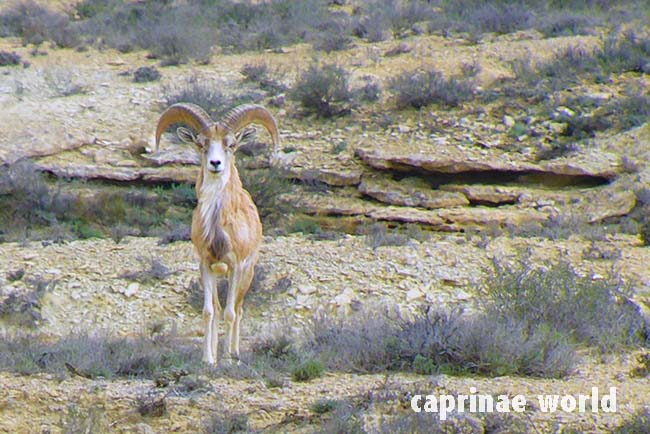
Young Transcaspian Urial ram in its steppe environment on the Fetisovo Plateau, Kazakhstan. Photo: Francis Morlon, 2009-05-01
Population
The population was estimated to be at least 20.000 animals in the mid-1970s (Valdez and DeForge, 1985), of which around 15.000 were estimated to inhabit Golestan National Park alone (Kiabi, 1978). [7]
The total number estimated in ex-Soviet republics at the beginning of the 1990s was ca. 6.000 animals. Numbers had declined sharply before the mid-1960s.
Kazakhstan (Lankin 1982; Savinov and Bekenov, 1977):
mid-1960s: 3.000
by the 1970s: continued to decline to 2.000
beginning of the 1980s: and 1.500 [7]
During a survey in Mangghystau Province, West Kazakhstan in 2009 only 1 animal was observed. [5]
Turkmenistan:
In the early 1980s: 800
along the shores of Kara-Bogaz Gol: 500
in the southern ravines of Kara-Bogaz Gol: 300 (Zarkhidze and Gorbunov, 1983).
Following protection resulting from its listing in the USSR Red Data Book, numbers of this subspecies began to increase in the latter half of the 1980s with some populations reestablishing themselves naturally. However, since the early 1990s the populations appear to have once more declined. [7]
Uzbekistan:
1983: about 300; have since declined (O. Tsaruk, in litt., 1994),
with ca. 40 near the border with Turkmenistan (B. Dyakin pers. comm. to E. Mukhina, 1995) [7]; in Northwestern Uzbekistan ((editior’s note: which corresponds with the total range in this country)) the urial population is believed to be small and numbers may range from 100 to 300 individuals. [2]
Iran: no recent estimates. [7]
Threats
Poaching remains a major threat and is the cause of the latest declines in the ex-Soviet republics. It is carried out by locals, especially around the limited waterholes used by the Urial, using both firearms and snares (Fedosenko, 1986; Gorbunov, 1986). In Iran the threats include habitat destruction, poaching and competition from livestock. [7]
Conservation
The Transcaspian Urial is found in the following protected areas, wildlife refuges and national parks:
Turkmenistan: Kaplankyr
Kazakhstan: Ustyurt (about 600)
Iran: Golestan National Park, Khar Touran National Park and Tandoureh National Park; Bagh-e Keshmir, Sarany, Sarigol, Salook and Tandoureh Protected Areas; Heidary, Khoshyeilaq, Miandash, Shirahmad and Touran Wildlife Refuges [2]
Trophy hunting: In Iran, Caprinae – including Transcaspian Urial – are the only game mammals that can be hunted under licences issued by the Department of the Environment.
The hunting season for Caprinae lasts four months beginning each year in September, but each licence is valid only for five days from its date of issue. Hunters with non-automatic and semi-automatic weapons can obtain a licence and are permitted to shoot a wild sheep (or a wild goat). Each hunter can obtain up to four licences per hunting season, and may shoot three males and one female.
Unfortunately the exact numbers of Caprinae shot each year by hunters are not available. According to recent data (2008), between 2.200 and 3.200 licences were issued each hunting season, and a rough estimate of the number Caprinae legally shot each year would be between 2.000 to 3.000 animals. However, more than twice this number are estimated to be killed by poachers annually. Hunting is permitted in protected areas but requires a special licence. Because Caprinae populations are not harvestable in most areas, licences are almost never issued for protected areas. [7]
Ecotourism
not a factor
Literature cited
[1] Castelló, José R., 2016: Bovids of the World – Antelopes, Gazelles, Cattle, Goats, Sheep, and Relatives. Princeton University Press
[2] Damm, Gerhard R. and Franco, Nicolás, 2014: The CIC Caprinae Atlas of the World – CIC International Council for Game and Wildlife Conservation, Budakeszi, Hungary in cooperation with Rowland Ward Publications RSA (Pty) Ltd., Johannesburg, South Africa
[4] Groves, Colin and Grubb, Peter, 2011: Ungulate Taxonomy. The John Hopkins University Press
[5] Le Nevé, A., Gouraud, C., Morlon, F. & Judas, J. (2010). Kazakhstan nature trip report; March to June 2009. National Avian Research Center. Unpublished. 69 p. (3) (PDF) Kazakhstan Nature Trip Report 2009.
Available from: https://www.researchgate.net/publication/309533797_Kazakhstan_Nature_Trip_Report_2009
[7] Valdez, R. 2008. Ovis orientalis. The IUCN Red List of Threatened Species 2008: e.T15739A5076068. http://dx.doi.org/10.2305/IUCN.UK.2008.RLTS.T15739A5076068.en. Downloaded on 17 April 2019.
[13] Valdez, Raul, 1982: The wild sheep of the world. Wild Sheep and Goat International, Mesila, New Mexico 88046
[16] Wilson, D. E. and Mittermeier, R. A. [eds], 2011: Handbook of the mammals of the world. Vol. 2. Hoofed mammals. Lynx Edicions, Barcelona.

